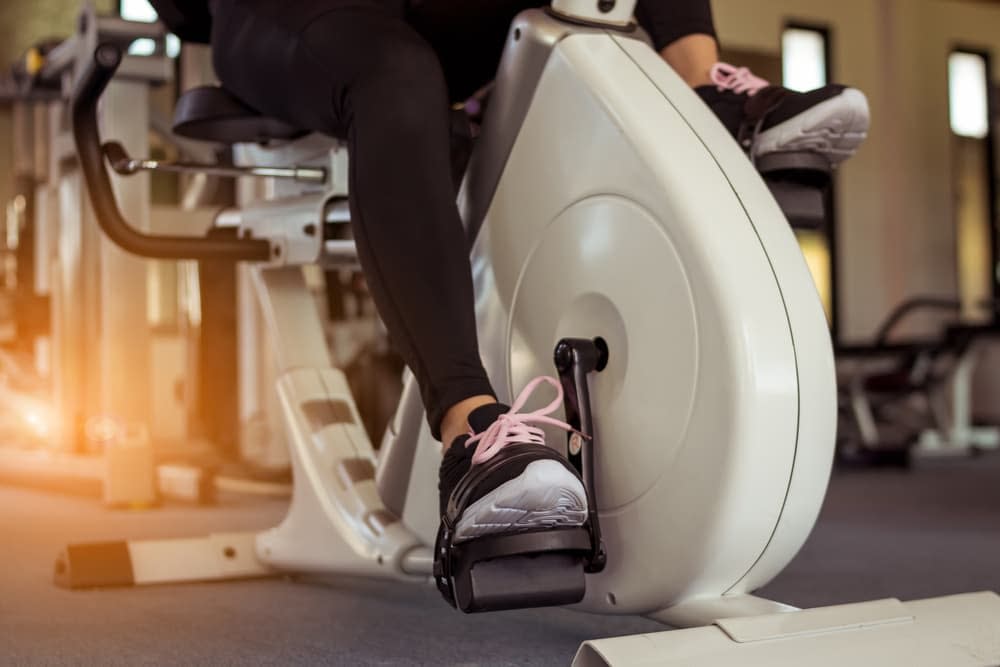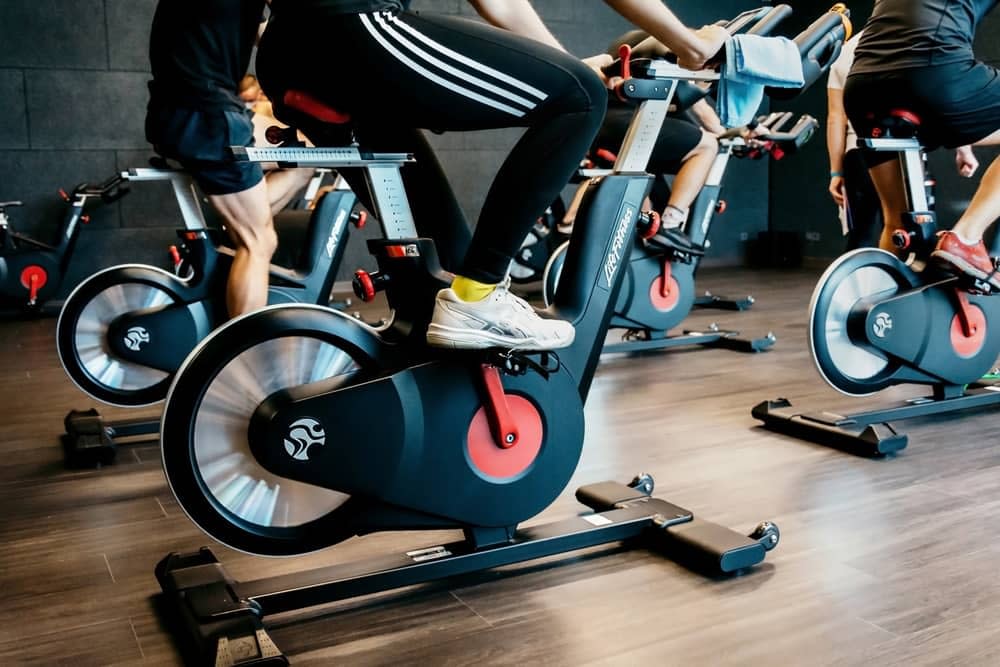If the overall feel of your cycling workout is essential to you, then yes, evaluating exercise bike flywheel weights matters. Flywheel weights indicate how easy or hard it is for the bike to build and maintain momentum.
In other words, you’ll want to use an exercise bike with the correct flywheel weight if you prefer smooth and comfortable cycling sessions.
There are various flywheel weights available, depending on the bike model. Some are light, while others are heavy.
The question is, which one suits your workout? What factors should you consider to determine which flywheel type is best?
Let’s look at this feature further and differentiate light from heavy flywheels.
To help you decide, I will identify the usual flywheel weights, match them with the ideal users, and suggest specific exercise bike models for each.
- What is an Exercise Bike Flywheel?
- Why is Evaluating Exercise Bike Flywheel Weights Important?
- What is the Difference Between Light and Heavy Exercise Bike Flywheels?
- Which Exercise Bike Flywheel Weight is Best?
- Final Thoughts on Exercise Bike Flywheel Weights
- Other Questions on Exercise Bike Flywheel
What is an Exercise Bike Flywheel?
The flywheel is the round disc at the front or back of your exercise bike.
Some models have exposed flywheels, while others are underneath a plastic shell or cover.
With indoor cycling bikes, the chain or belt drive system connects the pedals with the flywheel. As you step on the pedal, the drive system starts to move, rotating the flywheel and allowing you to ride the stationary bike.
Why is Evaluating Exercise Bike Flywheel Weights Important?
A properly rotating exercise bike flywheel may seem good enough. But its weight is also a factor to consider because:
- It suggests the exercise bike lifespan. A flywheel with a good weight can withstand constant or intense pedalling force better than a lightweight wheel. Bikes with more robust flywheels are likely to deliver top-notch performance for longer.
- It affects the riding experience. Momentum is the specific factor that makes your bike ride smooth or choppy. And the flywheel weight is a good momentum indicator. Specifically, heavy flywheels slowly build up momentum and maintain it for longer. On the other hand, lighter flywheels allow more revolutions or speed to enable smooth momentum.
- It indicates the exercise bike cost. Stationary bikes with light flywheels tend to be less expensive than heavier ones. Note that flywheel weight and bike cost do not always translate to the level of quality. Some manufacturers can now balance bike construction and cost to avoid sacrificing performance.

What is the Difference Between Light and Heavy Exercise Bike Flywheels?
Here’s a table for a quick comparison of the two.
| LIGHT FLYWHEEL | HEAVY FLYWHEEL |
| 4.5 kg or less | 9 kg or more |
| Spins faster to produce more momentum | Generates and maintains smooth momentum |
| Requires less effort to start and stop the pedals | Requires more effort to start and stop the pedals |
| Feels lighter on the joints | Feels heavier on the joints |
Let’s evaluate these exercise bike flywheel weights further.
Light flywheel
Exercise bikes with a light flywheel are for high-speed cycling.
A lighter flywheel weight allows the rider to push the pedals down quickly and produce several revolutions per stroke.
This bike type suits users who prefer to jump straight into their cycling session rather than slowly build up momentum.
However, the problem with this design is that riders won’t be able to generate enough inertia for smoother cycling. This explains why bikes with lighter flywheels tend to feel wobbly.
Due to slight performance issues, some cyclists think light flywheel bikes are synonymous with budget or entry-level machines.
It’s not always the case, though, considering that there are bike models that perform well even with light flywheels.
Despite these drawbacks, exercise bikes with a light flywheel are still best if:
- You have problems with your joints. Lighter flywheels are gentler than their heavy counterparts. These require less effort from your joints to start and stop pedalling.
- You prefer less intense exercises. Light flywheels are an excellent choice for riders into steady-state cycling or sessions that do not require constant resistance and speed changes, like HIIT.
- You want to target your hamstring and glutes more. The quads are the primary power source of indoor cycling. But if you prefer to shift your lower-body workout to the posterior muscles, consider riding a bike with a light flywheel.
Heavy flywheel
Exercise bikes with a heavy flywheel are for outdoor or studio-like cycling.
A heavier flywheel weight allows the rider to slowly build momentum and maintain it for a seamless riding experience.
Generally, the heavier the flywheel, the smoother your ride will be. However, heavy flywheel bikes are also harder to control, especially their speed.
Moving the pedals and stopping the bike can be straining on the joints. Cyclists without ample body strength may struggle with this indoor bike type.
Nonetheless, exercise bikes with a heavy flywheel are best if:
- You enjoy intense training. The extra weight of a heavy flywheel adds stability to the indoor exercise bike. And this is why heavy flywheel bikes are generally better and safer during vigorous cycling.
- You prefer a smoother and more realistic riding experience. As heavy flywheel bikes can maintain momentum, these machines are ideal for uphill climbs, interval training, and other cycling variations.
- You are a seasoned rider. Experienced cyclists naturally have more strength and stamina to get heavy flywheel bikes going.

Which Exercise Bike Flywheel Weight is Best?
Using light and heavy categories when evaluating exercise bike flywheel weights may still be too broad for you.
So, to make evaluation easier, I categorised the exercise bikes into specific flywheel weight ranges.
I also added a few recommended exercise bike models for each group.
For seniors: 8 to 10 kg
This flywheel weight category includes entry-level exercise bikes that suit low-intensity cycling.
Middle-aged users and seniors will likely prefer options under this group.
Bikes with 8-10 kg flywheels also fit riders who love indoor cycling to maintain physical fitness and boost cardio health.
Some examples are:
- Lifespan Fitness Exer-80 Bike. This upright model has a 6 kg cast-iron flywheel. Aside from its 16 adjustable resistance levels and 12 automated training programs, its compact size should fit even your small workout space.
- Endurance Elite Fit Pro Bike. This recumbent exercise bike model has a 10 kg magnetic flywheel. Its user-friendly screen and padded seat with backrest guarantee comfortable cycling sessions.
For home users: 11 to 15 kg
This flywheel weight category includes indoor exercise bikes for steady-state and interval cycling.
Regular gym-goers and fitness enthusiasts who enjoy exercise variety will prefer this group.
Bikes with 11-15 kg flywheels are ideal for burning calories and fat. These models also encourage body toning and core strengthening.
Some examples are:
- Lifespan Fitness SP-310 (M2) Bike. This spin bike model has a 13 kg TrueSpin Precision flywheel. It’s an affordable machine with a chain drive system – perfect for simulating an outdoor cycling experience.
- NordicTrack Commercial S22i Studio Bike. This premium spin bike boasts a 13 kg inertia-enhanced flywheel. Its massive display screen, auto incline-decline function, and iFit compatibility are impressive.
For athletes and pros: 16 to 20 kg
This flywheel weight category includes professional-grade exercise bikes that suit special or intense physical training.
With resistance added, these bikes are very challenging to use, especially for riders with average or lower fitness capacities.
Some examples are:
- BH Fitness SB3 Magnetic Spin Bike. This model features an 18 kg high-rotational-inertia flywheel made of aluminium. Its magnetic brake system and anti-sweat protection suit quiet and intense workouts.
- Vortex V1000 Exercise Bike. This spin bike has a 20 kg steel flywheel. It boasts professional cycling features, including multi-grip handlebars and adjustable racing pedals, minus the hefty price tag.
Note that some exercise bikes may have flywheels that weigh up to 25 kg.

Final Thoughts on Exercise Bike Flywheel Weights
Evaluating the exercise bike flywheel weight is a must, whether you want an upright, spin, or recumbent type.
Doing so ensures that your machine suits your fitness level, preferred riding experience, and budget.
I suggest shopping in-store, aside from reading reviews and buying guides for finding the best exercise bike.
Try a few bike options to get a feel of the different flywheel weights. Then, choose one that feels the most comfortable and that you can use daily without problems.
Other Questions on Exercise Bike Flywheel
1. Is an exercise bike with a heavy flywheel better?
An exercise bike with a heavy flywheel provides a smoother riding experience. But it is not always the better option. Lightweight flywheels also have good points, like budget and joint-friendliness, that match specific users. The choice still depends on your fitness capacity and preference.
2. Does riding an exercise bike with a heavy flywheel burn more calories?
Exercise bikes with light or heavy flywheels can help you burn calories. But the number of calories you burn relies more on workout intensity that you derive from the bike’s resistance level (Kaya et al. 2018), not on its flywheel weight. The more resistance you apply on the flywheel, the more intense the exercise, and the more calories you burn. Your cycling duration is another contributing factor to your calorie burn rate.
- Is a Yoga Wheel Good for Back Pain? - 26 July 2024
- How to Work the Arms on Stationary Bikes (5 Ways) - 5 January 2024
- Should You Use a Treadmill Before or After Weight Training? - 4 January 2024

